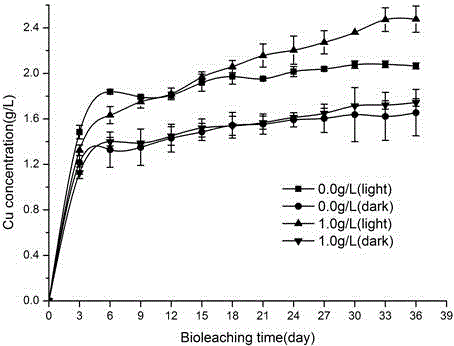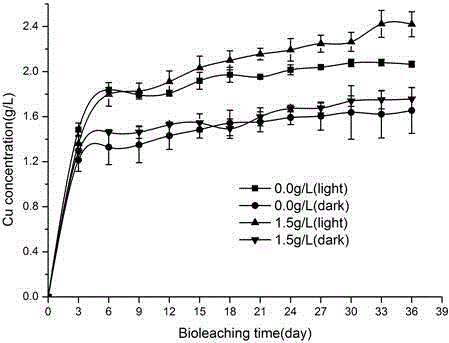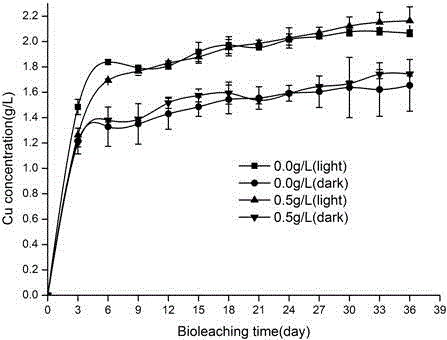Method for promoting bacterial leaching of photocatalytic semiconductor sulphide minerals through graphene
A semiconductor and photocatalytic technology, applied in the direction of using microorganisms, bacteria, and adding compounds to stimulate growth, etc., can solve the problem of low utilization rate of photogenerated electrons
- Summary
- Abstract
- Description
- Claims
- Application Information
AI Technical Summary
Problems solved by technology
Method used
Image
Examples
example 1
[0022] The method described in this embodiment mainly proceeds according to the following steps:
[0023] (1) Crushing the chalcopyrite into a particle size of more than 200 meshes, and using XRD technology to analyze the main components of the minerals, XRF technology to analyze the composition of mineral elements, and the medium is prepared according to the formula of 9K medium;
[0024] (2) Inoculate Thiobacillus acidophilus with 10% inoculum amount into 9K medium containing 1% chalcopyrite for the first acclimatization, count the number of live cells by hemocytometer method regularly every day, when Bacterial concentrations can reach 10 8 -10 9 individual / ml, complete the first domestication, remove the slag, collect the bacteria by centrifugation, repeat the above steps, and carry out domestication in the chalcopyrite slurry containing 2%, until the acidic Thiobacillus ferrochloride can tolerate 2% chalcopyrite pulp concentration;
[0025] (3) The domesticated acidophi...
Embodiment 2
[0031] The method described in this embodiment mainly proceeds according to the following steps:
[0032] (1) Crushing the chalcopyrite into a particle size of more than 200 meshes, and using XRD technology to analyze the main components of the minerals, XRF technology to analyze the composition of mineral elements, and the medium is prepared according to the formula of 9K medium;
[0033] (2) Inoculate Thiobacillus acidophilus with 10% inoculum amount into 9K medium containing 1% chalcopyrite for the first acclimatization, count the number of live cells by hemocytometer method regularly every day, when Bacterial concentrations can reach 10 8 -10 9 individual / ml, complete the first domestication, remove the slag, collect the bacteria by centrifugation, repeat the above steps, and carry out domestication in the chalcopyrite slurry containing 2%, until the acidic Thiobacillus ferrochloride can tolerate 2% chalcopyrite pulp concentration;
[0034] (3) The domesticated acidophi...
Embodiment 3
[0040] The method described in this embodiment mainly proceeds in the following steps:
[0041] (1) Crushing the chalcopyrite into a particle size of more than 200 meshes, and using XRD technology to analyze the main components of the minerals, XRF technology to analyze the composition of mineral elements, and the medium is prepared according to the formula of 9K medium;
[0042] (2) Inoculate Thiobacillus acidophilus with 10% inoculum amount into 9K medium containing 1% chalcopyrite for the first acclimatization, count the number of live cells by hemocytometer method regularly every day, when Bacterial concentrations can reach 10 8 -10 9 individual / ml, complete the first domestication, remove the slag, collect the bacteria by centrifugation, repeat the above steps, and carry out domestication in the chalcopyrite slurry containing 2%, until the acidic Thiobacillus ferrochloride can tolerate 2% chalcopyrite pulp concentration;
[0043] (3) The domesticated acidophilic iron-s...
PUM
| Property | Measurement | Unit |
|---|---|---|
| particle size (mesh) | aaaaa | aaaaa |
Abstract
Description
Claims
Application Information
 Login to View More
Login to View More - R&D
- Intellectual Property
- Life Sciences
- Materials
- Tech Scout
- Unparalleled Data Quality
- Higher Quality Content
- 60% Fewer Hallucinations
Browse by: Latest US Patents, China's latest patents, Technical Efficacy Thesaurus, Application Domain, Technology Topic, Popular Technical Reports.
© 2025 PatSnap. All rights reserved.Legal|Privacy policy|Modern Slavery Act Transparency Statement|Sitemap|About US| Contact US: help@patsnap.com



